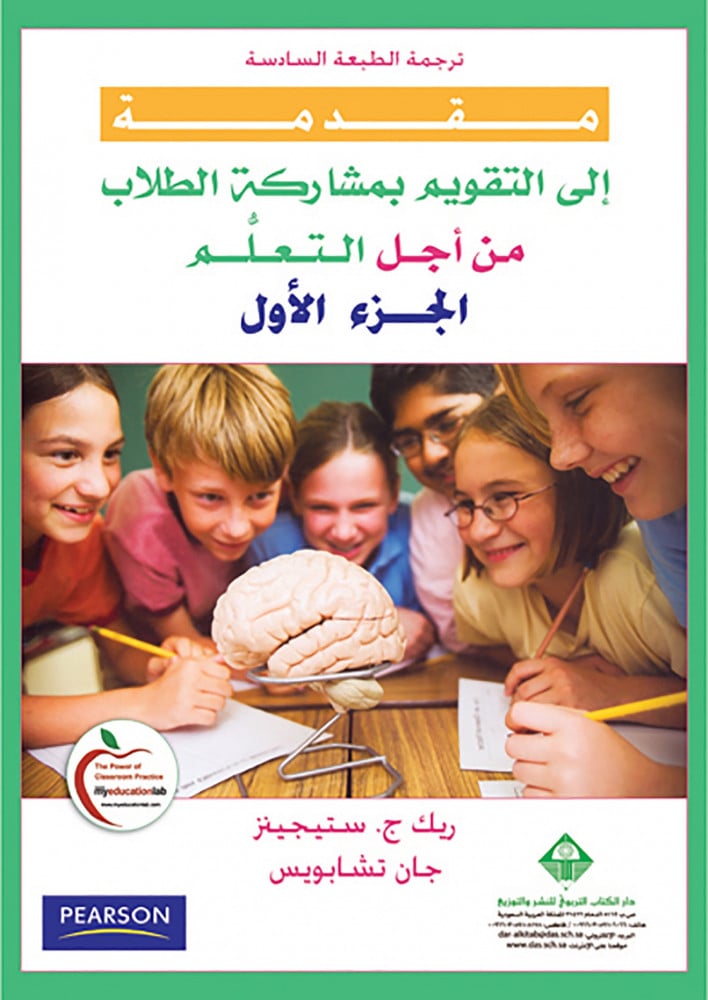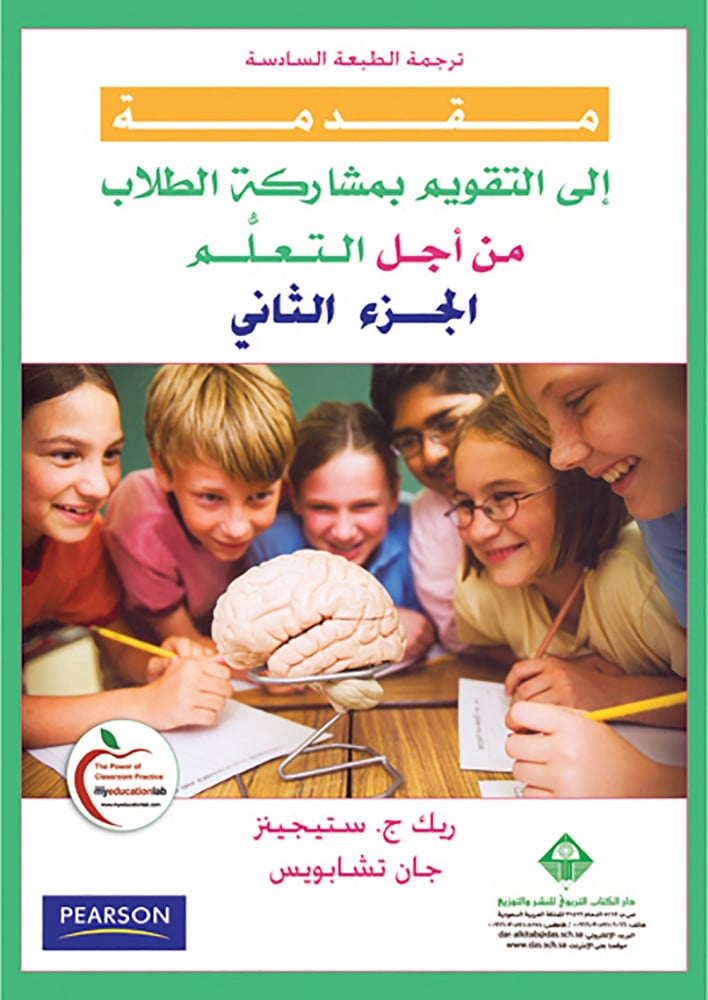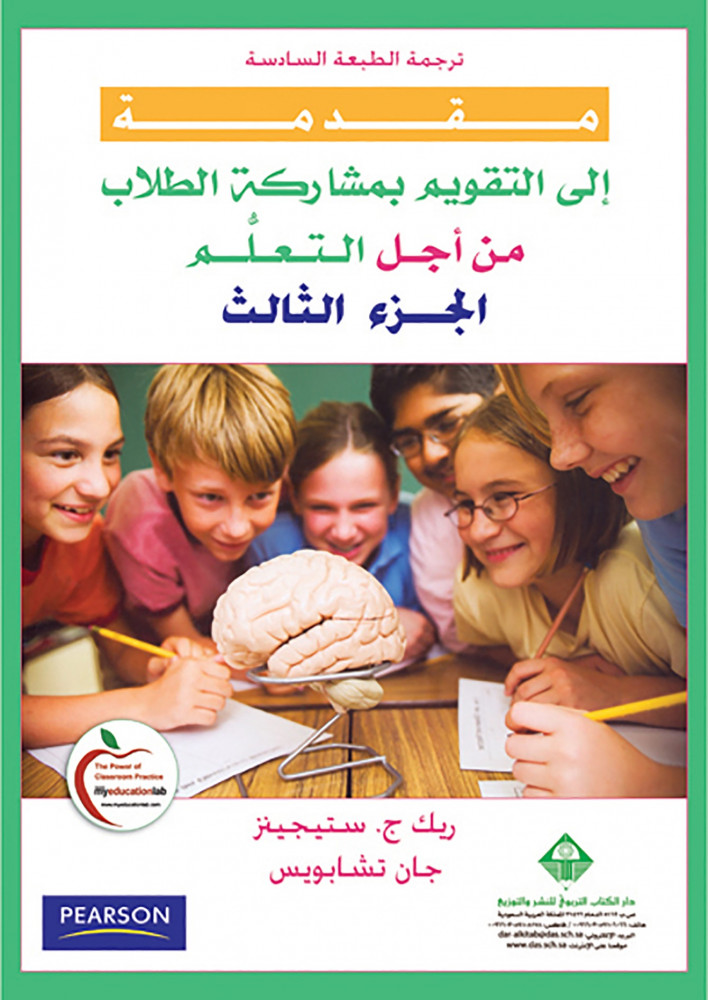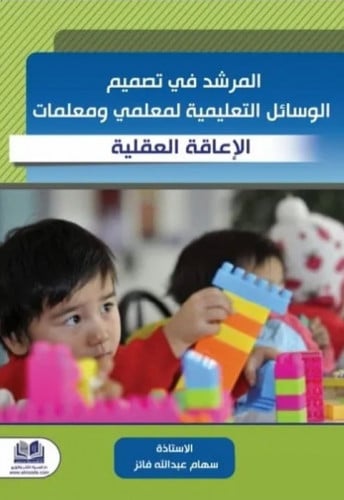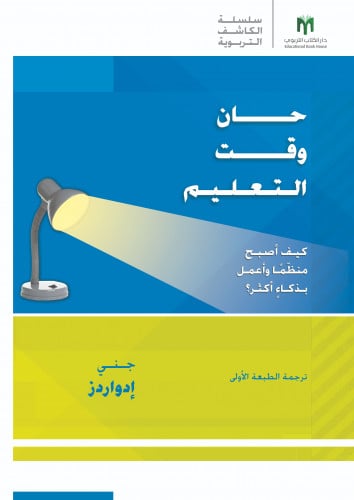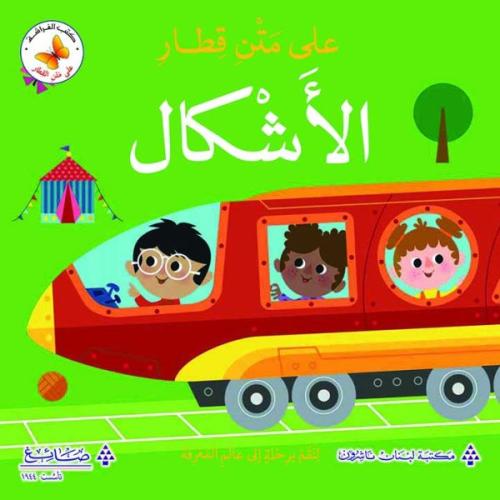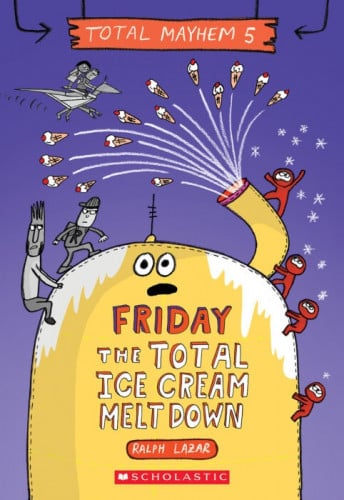AVAILABLE IN ARABIC
About This Book
Written for pre-service teacher candidates who have little or no classroom experience, Rick Stiggins’ multiple award-winning and market-leading text focuses squarely on preparing new teachers to assess students in classrooms, providing them with their initial orientation to classroom assessment and to the challenges they will face in monitoring student learning, in using the assessment process, and its results to benefit their students. The text clearly instructs teaching candidates on how to gather dependable evidence of student learning using quality assessments and how to use those assessments to support and to certify student learning. The book has an exceptionally strong focus on integrating assessment with instruction through student involvement in the assessment process; it is clearly the most non-technical and hands on practical orientation to assessment validity and reliability yet developed. It offers five easy-to-understand keys to effective classroom assessment practice that any teacher can learn to apply. The presentation covers the full range of classroom assessment methods, when and how to use them and how to communicate results in ways that support learning. Examples and models are offered across grade levels and schools subjects to assist candidates in learning these things. The treatment of student-involved assessment, record keeping, and communication as an instructional intervention is a unique entity of the text. Specific assessment strategies are offered throughout for helping students see the learning target from the beginning and then watch themselves move progressively close over time until they achieve ultimate learning success. Showing how to use assessment to accurately reflect student achievement and how to benefit–not merely grade–student learning, the text examines the full spectrum of assessment topics, from articulating targets, through developing quality assessments and communicating results effectively.
Topics : Assessment
Table Of Content
PART I: Keys to Classroom Assessment Quality
Chapter 1: Classroom Assessment for Student Success
Chapter Focus
A Teacher's Classroom Assessment Responsibilities
A Story of Assessment for Student Success
Success from the Student's Point of View 7
The Keys to Success
Some Students Aren't So Lucky
Other Potential Problems
Anticipating and Avoiding Assessment Problems
We Need "Valid" Assessments
We Need "Reliable" Assessments
Assessment FOR Learning: GPS for Student Success
The Changing Mission of Schools and Role of Assessment
Important Benefits to You
A Fundamental Assessment Belief
The Emotional Dynamics of Assessment
A Special Note about Struggling Learners
Guides to Valid and Reliable Assessment Effectively Used
Guiding Principle 1: Start with a Clear Purpose: Why Am I Assessing?
Guiding Principle 2: Start with Clear and Appropriate Achievement Targets: Assess What?
Guiding Principle 3: Create High-Quality Assessments That Yield Dependable Information
Guiding Principle 4: Communicate Results Effectively
An Overarching Principle: Student Involvement
Summary. The Importance of Sound Assessment
Practice with Chapter 1 Ideas
Chapter 2: Understanding Why We Assess
Chapter Focus
Our Balanced Assessment Mission
Classroom Users and Uses
Interim/ Benchmark Assessment Users
Users and Uses of Annual Tests
Generalizations across Levels of Users and Uses
Therefore, the Keys to Assessment FOR Learning Summary: Assessment for Many Purposes
Practice with Chapter 2 Ideas
Chapter 3: Clear Achievement Expectations: The Foundation of Sound Assessment
Chapter Focus
Validity in Terms of Learning Targets
Defining Achievement Targets
Arguments in Favor of Clear and Appropriate Targets Benefit 1: Control of Your Professional Success
Benefit 2: Enhanced Student Academic Self-Efficacy
Benefit 3: Greater Assessment Efficiency
Benefit 4: Accurate Classroom Assessments
Sources of Information about Achievement Expectations Common Core Achievement Standards
State and Local Standards
Local Written Curriculum
Professional Development and Networking
Learning Targets for the Twenty-First Century Knowing and Understanding Targets
Reasoning Targets
Performance Skills Targets
Product Development Targets
Disposition Targets—the Affective Domain
Summary of Targets
The Critical Connection: Standards to Classroom Learning Targets
Scaffolding Standards
Student-Friendly Targets
Summary: Clear Targets Are Essential for Sound Assessment
Practice with Chapter 3 Ideas
Chapter 4 Designing Quality Classroom Assessments
Chapter Focus
The Assessment Options
Selected Response Assessment
Essay Assessment
Performance Assessment
Personal Communication as Assessment
Keep All Options in Play
Prior to Beginning Design: Know Your Learning Target(s)
Design Feature 1: Matching Methods with Learning Targets
Assessing Content Knowledge and Understanding
Assessing Reasoning Proficiency
Assessing Mastery of Performance Skills
Assessing Proficiency at Creating Products
Assessing Dispositions
Some Final Points about Target-Method Match
The Remaining Three Design Features of Quality Assessments
Design Feature 2: Sample Achievement Appropriately
Design Feature 3: Build the Assessment of Quality Exercises, Tasks, Items, and
Scoring Procedures
Design Feature 4: Minimize Bias
Assessment FOR Learning
Summary: A Vision of Excellence in Classroom Assessment
Practice with Chapter 4 Ideas
PART II: Understanding Assessment Methods
Chapter 5: Selected Response Assessment
Chapter Focus
The "Conventional" Assessment Methods
When to Use Selected Response Formats
The Myth of Objectivity
Matching Method to Learning Target
Assessing Knowledge Mastery
Assessing Reasoning
Assessing Performance Skills
Assessing Products
Summary of Achievement Target Matches
The Steps in Assessment Development
Step 1: Preparing a Blueprint
Step 2: Selecting the Specific Material to Assess
Additional Thoughts on Steps 1 and 2
Step 3: Building Test Items from Propositions
Fine Tuning Assessment Applications
Mix Formats Together
Use Interpretive Exercises
Format the Test Carefully
Work Backwards to Verify Test Quality
Some Final Reminders
Barriers to Sound Selected Response Assessment
Student Involvement in Selected Response Assessment
Summary: Productive Selected Response Assessment
Practice with Chapter 5 Ideas
Chapter 6: Written Response (Essay) Assessment
Chapter Focus
Assessment Based on Subjective Judgment
The Foundations of Assessment Quality
When to Use Essay Assessment
Understanding Reliability: The Role of Judgment in Scoring
Matching Method to Targets
Assessing Knowledge and Understanding
Assessing Reasoning
Assessing Performance Skills
Assessing Product Development Capabilities
Summary of Target Matches 126 Developing Essay Assessments
Preliminary Practice Exercise
Assessment Planning
Exercise Development
Developing Essay Scoring Procedures
Barriers to Sound Essay Assessment
Student Involvement in Essay Assessment
Summary: Tapping the Potential of Essay Assessment
Practice with Chapter 6 Ideas
Chapter 7: Performance Assessment
Chapter Focus
Assessment Based on Observation and Professional Judgment
The Promise and Perils of Performance Assessment
The Foundations of Quality
Performance Assessment Is a Matter of Judgment
Understanding Reliability: Inter-Rater Agreement
Matching Method to Targets
Assessing Knowledge
Assessing Reasoning
Assessing Performance Skills
Assessing Products
Summary of Target-Performance Assessment Matches
Developing Performance Assessments
Remember to Never Lose Track of Your Purpose
Defining Performance
Devising Performance Tasks
Fine Tuning Your Use of Performance Assessments
Barriers to Sound Performance Assessment
Think Assessment FOR Learning: Involve Students in Performance Assessment
Summary. Thoughtful Development Yields Sound Assessments and Energized Students
Practice with Chapter 7 Ideas
Chapter 8: Personal Communication as Assessment
Chapter Focus
Tapping the Power of Classroom Interaction as Evidence of Learning
Keys to Effective Use
Understanding Validity and Reliability Issues
Matching Method to Targets
Assessing Knowledge and Understanding
Assessing Reasoning
Assessing Performance Skills and Products
Summary of Target Matches
The Many Forms of Personal Communication as Assessment
Instructional Questions and Answers
Conferences and Interviews
Class Discussions
Oral Examinations
Journals and Logs: Naturals as Assessments FOR Learning
Student-Involved Assessment FOR Learning
Summary: Person-to-Person Assessment
Practice with Chapter 8 Ideas
Chapter 9 Assessing Dispositions
Chapter Focus
Students Who Are Predisposed to Succeed
Assessment FOR Learning Engages Student Dispositions
A Crucial Difference between Achievement and Affect 196 Two Very Important Ground Rules
Ground Rule 1: Remember, This Is Personal
Ground Rule 2: Stay in Bounds
Defining Affect as It Relates to Dispositions
School-Related Attitudes
School-Related Values
Academic Self-Efficacy
Academic Interests
Academic Aspirations
Assessment Anxiety
Variations in Dispositions
Matching Method to Targets
Questionnaires
Performance Observations as Assessments of Dispositions
Personal Communication as a Window to Student Feelings
Summary. Dispositions That Boost Achievement
Practice with Chapter 9 Ideas
PART III: Communicating Assessment Results
Chapter 10: Record Keeping: The Foundation of Effective Communication
Chapter Focus
Good Records Underpin Good Communication
1. Keep Records by Achievement Target
2. Keep Records According to Purpose
3. Keep Accurate Records
4. From Records to Useful Information
5. Record Keeping Illustrated
Summary: Going for the Record
Practice with Chapter 10 Ideas
Chapter 11: Report Cards: Summarizing Assessments OF Learning
Chapter Focus
Report Card Grading
Understanding Our Current Grading Environment
Communicate about What?
Achievement as a Grading Factor
Aptitude as a Grading Factor
Effort as a Grading Factor
Compliance as a Grading Factor
Attitude as a Grading Factor
Summary of Grading Factors
Gathering Achievement Evidence for Grading Purposes
Step 1: Spelling Out the Big Achievement Picture
Step 2: Turning Your Big Picture into an Assessment Plan
Step 3: From a Plan to Actual Assessments
Step 4: Summarizing the Resulting Information
Report Cards That Deliver Greater Detail
Standards-Based Reporting 248 Narrative Reporting
Summary: Communicating with Report Cards
Practice with Chapter 11 Ideas
Chapter 12: Portfolios as Rich Communication
Chapter Focus
Student-Involved Communication Part 1: Portfolios
Portfolios Provide the Details
Benefits for Teachers and Students
Portfolios Assessment? No
Keys to Successful Use
Portfolios as Assessment FM Learning Tools
Dealing with Some Practicalities
Summary: Communication with Portfolios
Practice with Chapter 12 Ideas
Chapter 13: Conferences as Productive Communication
Chapter Focus
Student-Involved Communication Part 2: Conferences
A Productive Experience for All
Necessary Conditions
Conference Formats That Enhance Communication and Learning
Student-Teacher Conferences
Parent-Teacher Conferences
Student-Led Parent Conferences
Communication FOR Learning
Summary: Student-Involved Communication
Practice with Chapter 13 Ideas
Chapter 14: Communicating with Standardized Test Scores
Chapter Focus
Tests That Produce Comparable Results
Background Information
The Various Layers of Annual Testing
The Result: Troubling Contradictions
Addressing the Problems: A Guiding Philosophy
Standardized Test Development
Step 1: Clarify Targets
Step 2: Translate Targets into Assessments
Step 3: Develop Test Items
Step 4: Assemble Test and Evaluate for Appropriateness
Step 5: Administer Test to Establish Norms (Norm-Referenced Tests)
Setting Standards of Acceptable Performance (Criterion-Referenced Tests) Interpretation of Commonly Used Test Scores
Scores Reported on State Assessments
Scores Reported on Norm-Referenced Tests
Implications for Teachers
Above All, Protect the Well-Being of Your Students!
Also, Build Community Awareness
Finally, Maintain Perspective
Summary: Productive Standardized Testing
The End of Our Studies of Classroom Assessment
Practice with Chapter 14 Ideas
APPENDIX A: Detailed Analysis of Assessment Users and Uses
APPENDIX B : Rubrics for Evaluating Assessment Quality
APPENDIX C: Derivation of Common Norm-Referenced Scores
References
Index
About the Authors
Rick J. Stiggins:

an Chappuis (JC): Rick Stiggins and his wife, Nancy Bridgeford, had recently founded the Assessment Training Institute here in Portland, Oregon to address a major gap in preservice education programs: teachers were generally not prepared to engage in effective assessment practices. The summer conference began as a way to bring together like-minded professionals to further ATI’s mission—to develop understanding of how day-to-day classroom assessment can and should serve learning. Today, 23 years later, “going to Portland” has been a transformational experience for thousands of educators in the US and around the world.
Jan Chappuis:

Educator and author Jan Chappuis has been an elementary and secondary teacher as well as a curriculum developer in English / language arts, mathematics, social studies, and world languages. For the past twenty-five years, she has written books and developed workshops focused on classroom assessment literacy. A respected expert and thought leader in the area of formative assessment, Jan has presented both nationally and internationally and is best known for her work in translating research into practical classroom applications. Having worked with Rick Stiggins at the Assessment Training Institute in Portland, Oregon for more than a decade, Jan is currently a writer and independent consultant specializing in classroom assessment practices that support learning.
ISBN: 9789960863849
Author: Rick J. Stiggins & Jan Chappuis
Publisher: Educational Book House
Publish Year: 2013
Size: 17*24cm
Pages number: 576

